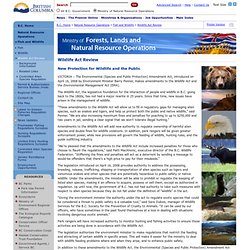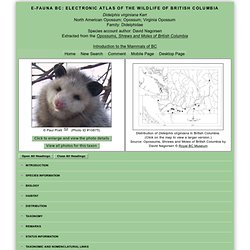

Wildlife Act. Part 1 — General Provisions Definitions and interpretation 1 (1) In this Act: "accompany" means to remain in the company of the other person, able to see the other person without the aid of any device other than ordinary corrective lenses and able to communicate by unamplified voice with that person; "amphibian" means a vertebrate of the class Amphibia and includes the eggs and other developmental life stages; "angler day" is a unit representing one person angling during any part of a day and is used to determine the extent to which a stream, lake or area specified under section 53 may be used for angling, for example, "a limit of 1 000 angler days" means that the total obtained by adding together the number of anglers using the stream, lake or area on each day of a specified period must not exceed 1 000; "angling" means catching or attempting to catch fish with a hook and line, with or without a rod, and includes (a) spear fishing or attempting to spear fish, and.
Invasive Plant Council of BC. Fish and Wildlife - Natural Resource Operations - Province of British Columbia. VICTORIA – The Environmental (Species and Public Protection) Amendment Act, introduced on April 16, 2008 by Environment Minister Barry Penner, makes amendments to the Wildlife Act and the Environmental Management Act (EMA).

The Wildlife Act, the legislative foundation for the interaction of people and wildlife in B.C. going back to the 1800s, has not had a major rewrite in 25 years. Since that time, new issues have arisen in the management of wildlife. “These amendments to the Wildlife Act will allow us to fill in regulatory gaps for managing alien species, such as snakes and tigers, and help us protect both the public and native wildlife,” said Penner. “We are also increasing maximum fines and penalties for poaching to up to $250,000 and two years in jail, sending a clear signal that we won’t tolerate illegal hunting.”
Amendments to the Wildlife Act will add new authority to regulate ownership of harmful alien species and double fines for wildlife violations. [Backgrounder] Fish and Wildlife - Natural Resource Operations - Province of British Columbia. Fish and Wildlife - Natural Resource Operations - Province of British Columbia. Ecosystems Branch – Contact. You can contact us at: Phone: 250-387-9500 Toll Free through Enquiry B.C.

(instructions below) Fax: 250-356-5104 Email: wildlife@victoria1.gov.bc.ca Mailing Address: Ecosystems Branch British Columbia Ministry of Environment PO Box 9338 Stn Prov Govt Victoria, BC V8W 9M1 Courier Address Ecosystems Branch British Columbia Ministry of Environment 4th Floor - 2975 Jutland Road Victoria, BC V8T 5J9 How to make a telephone call through Enquiry B.C. The Government of B.C. provides information to the public via a toll-free telephone information service called Enquiry BC. Enquiry BC is available Monday through Friday, 8AM to 5PM. Bill 29 — 2008: Environmental (Species and Public Protection) Statutes Amendment Act, 2008. HER MAJESTY, by and with the advice and consent of the Legislative Assembly of the Province of British Columbia, enacts as follows: Environmental Management Act SECTION 1: [Environmental Management Act, section 1] amends the definitions of "recyclable material" and "waste management facility". 1 Section 1 (1) of the Environmental Management Act, S.B.C. 2003, c. 53, is amended (a) in the definition of "recyclable material" by adding the following paragraph: (e) is any other material prescribed by the Lieutenant Governor in Council, or the minister under section 22 [minister's regulations — codes of practice]; , and (b) in the definition of "waste management facility" by adding ", or recovery of reusable resources, including energy potential from waste" after "a waste".

SECTION 2: [Environmental Management Act, section 21] amends the Lieutenant Governor in Council's regulation making power respecting security. E-Fauna BC Atlas Page. Movements and home range size have been studied by live-trapping and radiotelemetry.

There is no evidence that the North American Opossum is territorial: home ranges of adults and juveniles of both sexes seem to overlap extensively, and individuals may share the same den site. Home range estimates are from 5 to 39 hectares. Males tend to have larger home ranges than females, and home range size is larger in unproductive habitats such as intensively cultivated farm land. Adults generally travel 300 to 600 metres from their dens when foraging at night. The young usually remain close to the den, but when they disperse they may move long distances covering several kilometres in a single night. The North American Opossum is active between dawn and dusk.
The North American Opossum walks on the soles of its feet. North American Opossums are solitary. The opossum will employ any of several defence behaviours when it encounters a potential predator.